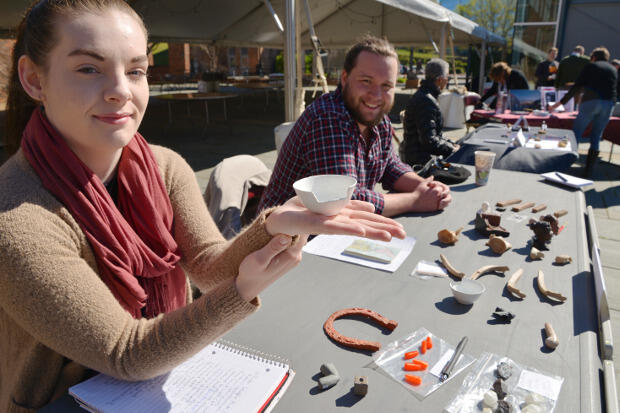
April 11, 2017
At Civil War Museum’s Emancipation Day, VCU students use 3-D printing to give hands-on glimpse into the lives of slaves in Virginia
Share this story
As part of the American Civil War Museum’s “Civil War and Emancipation Day: Voices for Freedom” event on Saturday, a team of Virginia Commonwealth University students gave visitors an opportunity to check out replicas of enslaved peoples’ artifacts that were 3-D scanned and printed in a VCU lab.
“The 3-D printing of these artifacts is a great way to get people involved. A lot of people certainly have been to museums and seen things like this, but it’s rare to get a chance to actually be able to handle the artifacts,” said Adam Blakemore, a senior majoring in anthropology and religious studies in the School of World Studies. “It’s a great way, especially for children — and even, in some cases, the visually impaired community — to get in touch with actual pieces of history.”
The artifacts were 3-D printed in the Virtual Curation Laboratory — part of the School of World Studies in the College of Humanities and Sciences — that specializes in the 3-D scanning and printing of artifacts from archaeological sites and museums in Virginia and across the country.
The 3-D printing of these artifacts is a great way to get people involved.
Bernard K. Means, Ph.D., director of the Virtual Curation Laboratory and an instructor of anthropology in the School of World Studies, said Saturday’s event was the third year that the lab’s interns have participated in the museum’s event that reflects on and celebrates the Emancipation of Richmond's formerly enslaved population, as well as the triumphs and struggles that followed Emancipation.
The idea of showcasing 3-D-printed artifact replicas from Virginia slaves, he said, is to help attendees find “meaning in interacting with these tangible reminders of a painful past."
The 3-D-printed artifact replicas on display Saturday included beads likely worn by slaves, quartz crystals believed to have been used as part of a ritual by enslaved people, pottery created by slaves, the bones of animals likely eaten by slaves, and much more. The original artifacts were found at sites such as George Washington's Mount Vernon, George Washington's Ferry Farm, George Mason's Gunston Hall, and Thomas Jefferson's Poplar Forest.
“We have a number of artifacts from enslaved context from all over Virginia,” said Madelyn Knighting, a junior anthropology major. “They all show a little bit about what daily life for an enslaved individual might have been like. We have a lot of faunal remains — animal remains — that show diet. We have pig ribs and sheep toes, and things like that.”
Subscribe for free to the VCU News email newsletter at http://newsletter.news.vcu.edu/ and receive a selection of stories, videos, photos, news clips and event listings in your inbox every Monday and Thursday.
Subscribe to VCU News
Subscribe to VCU News at newsletter.vcu.edu and receive a selection of stories, videos, photos, news clips and event listings in your inbox.










